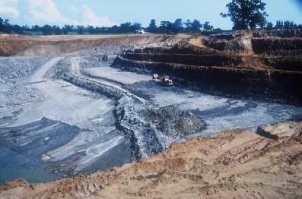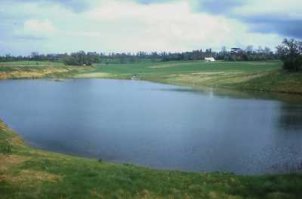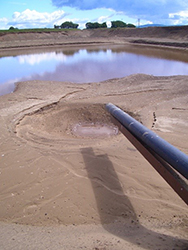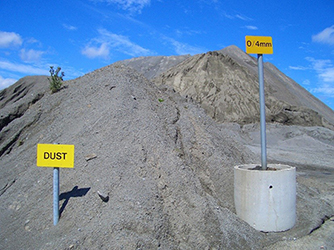Legislation and policy
In Britain, the legal framework for land-use planning is largely provided by town and country planning legislation. This aims to secure the most efficient and effective use of land in the public interest and to reconcile the competing needs of development and environmental protection. It has an important role to play in contributing to the Government's strategy for promoting sustainable development. Most forms of development in the UK, including mineral extraction and related activities, require planning permission before development can take place.
The majority of land-use planning decisions in Great Britain are made at a local level by local planning authorities. Responsibility for the operation of the system lies with:
- England: Department for Levelling Up, Housing & Communities
- Northern Ireland: Department for Infrastructure
- Scotland: Scottish Government
- Wales: Welsh Government
Each of these is responsible for developing national planning policy guidance, including that for mineral development, within which local authorities are required to operate.
In the UK, ‘minerals’ are defined in town and country planning legislation as 'all substances in, on or under land of a kind ordinarily worked for removal by underground or surface working, except that it does not include peat cut for purposes other than for sale'.
Minerals are valuable assets and vital to a modern economy. They are essential raw materials that underpin the manufacturing industry, construction and agriculture. Society enjoys important benefits from their extraction and use through their contribution to wealth creation, infrastructure, housing and consumer needs. However, the extraction of minerals, if not carefully designed and appropriately regulated, can have adverse effects on the landscape, environment and the quality of life of people living nearby. Modern mineral planning permissions mitigate or remove these potential effects entirely by ensuring that sites comply with national, regional and local policies for the supply of minerals.
Certain types of mineral are planned for on a strategic scale, for example industrial minerals such as silica sand and brick clay, whilst others are considered on a more regional or local scale, such as building stones that reflects the built character of a given area and promotes local distinctiveness when used in new buildings or the repair of heritage assets.
The overall aim of mineral planning is, therefore, to ensure that a steady and adequate supply of minerals remains in place to meet the demands of society at all times, whilst not unduly prejudicing amenity, future generations or the environment through their extraction. Areas of designated landscape, nature conservation or heritage value often have specific policies in place to either prevent or allow for mineral development only in very special or exceptional circumstances.
Mineral workings must provide 'net gains' in biodiversity upon their restoration and many mineral sites go on to become designated sites, such as local nature reserves (LNRs) or Sites of Special Scientific Interest (SSSIs) in recognition of their flora and fauna.
Mineral working is different from other forms of development in that:
- extraction can only take place where the mineral occurs in sufficient quantity and of the desired quality: 'minerals can only be worked where they are found'
- it is not a permanent use of land, even though operations may take place over a long time
- a modern restoration scheme must provide new and diverse environmental and amenity assets when mineral working ceases, which can often enable further economic benefit through industrial development: a good example of this is the Eden Project in Cornwall, where a former china clay pit is being used as a national educational and tourism resource


England
For England, the key national planning policies for minerals are set out in the National Planning Policy Framework (NPPF). The focus of the NPPF is a presumption in favour of sustainable development. The framework recognises that it is important that there is a sufficient supply of material to provide the infrastructure, buildings, energy and goods that the country needs whilst ensuring that permitted mineral operations do not have unacceptable adverse effects on the natural and historic environment or human health. The NPPF also recognises that, since minerals are a finite natural resource and can only be worked where they are found, it is important to make best use of them and to secure their long-term conservation through the mechanism of mineral safeguarding. Specific-mineral related policies can be found in Section 17 of the NPPF.
Northern Ireland
Under The Planning Act (Northern Ireland) 2011, the majority of planning functions in Northern Ireland were transferred to the 11 district councils. Policy and guidance are provided through the Strategic Planning Policy Statement for Northern Ireland (SPPS) published in 2015, which conforms to the Regional Development Strategy 2035. Where local development plans (LDPs) required by the 2011 Planning Act have not yet been produced, the remaining provisions of ‘A Planning Strategy for Rural Northern Ireland’ and retained national planning policies contained in planning policy statements must be considered.
Scotland
The Scottish planning system is centred around the National Planning Framework 4 (NPF4). Published in 2023, it details the long-term planning strategy for Scotland for a 20 to 30 year period and replaces NPF3 and the Scottish Planning Policy.
The Planning (Scotland) Act 2019 received royal assent in July 2019, amending the Town and Country Planning (Scotland) Act 1997.
Wales
In Wales, key national planning policies are set out in the Planning Policy Wales (PPW). As with the NPPF, the PPW has a similar focus on sustainable development that improves the well-being of future generations and recognises that society needs, and will continue to need for the foreseeable future, a wide range of minerals. Land-use planning policies for onshore oil and gas are contained in section 5.10 of the PPW; other minerals are contained in section 5.14.
The PPW is supplemented by a series of Minerals Technical Advice Notes (MTANs), Welsh Government Circulars and policy clarification letters. MTAN1 was published in 2004, giving detailed advice on planning for aggregates, and MTAN2 was published in 2009, giving advice about coal.
A local authority with responsibility for mineral planning, including deciding planning applications, is called a mineral planning authority (MPA). In Wales, Scotland, Northern Ireland and some parts of England, the responsibility for mineral planning resides with unitary authorities, which deal with all planning issues within their areas. In those parts of England with two tiers of local government (counties and districts), MPAs are the county council's responsibility. National Parks are also MPAs.
The planning responsibilities of MPAs are roughly divided into three:
- formulating policies and plans to guide future development ('forward planning')
- regulating individual developments that are proposed through deciding planning applications ('development management')
- policing of existing developments to ensure that they are working within any legal constraints outlined in the planning permission (‘monitoring and enforcement’)
A system of planning was introduced in England in 2004 through the Planning and Compulsory Purchase Act 2004. With regard to minerals planning, MPAs are required to produce a 'Minerals and waste development scheme', which specifies the local development documents that are to be development plan documents, the subjects and geographical areas to which they relate, and timetables for their production or revision (amongst other things). Collectively, these plans are referred to as the local plan.
In Wales and Scotland, MPAs produce development plans referred to as local development plans (LDPs), and in Northern Ireland, a local development plan comprises a plan strategy document and a local policies plan.
England
In England, the development plan for an area is made up of development plan documents known collectively as the local plan, which contain:
- strategic policies, which address the priorities for an area looking forward to at least 15 years from adoption of the plan
- non-strategic policies, which deal with more detailed matters
Where a single document is produced at the local level, strategic policies should be clearly distinguishable from non-strategic policies. Broad locations for development are shown on key diagrams and a policies map shows land-use designations and allocations reproduced from or based on an Ordnance Survey map.
Where approved at referendum, neighbourhood plans are also part of the development plan but do not deal with minerals issues.
Paragraphs 17 to 19 of the National Planning Policy Framework describe the plan-making framework in England and Government guidance on plan making in England provides further detail.
Northern Ireland
In Northern Ireland, the development plan comprises a policy strategy document and a local policies plan. Where these have not yet been adopted, plans prepared under the pre-2015 arrangements are still applicable, which were prepared by the former Department of the Environment.
Scotland
In Scotland, the National Planning Framework 4 (NPF4) sets out a national framework and policies, which local development plans operate at a local level. Regional spatial strategies (RSS) will work to develop regional approaches to deliver NPF4 across LDPs. The NPF4 is part of the statutory development plan under the planning arrangements outlined in the Planning (Scotland) Act 2019.
Wales
In Wales, the statutory development plan comprises the National Development Framework, strategic development plans (SDPs) and local development plans (LDPs). The National Development Framework and Planning Policy Wales together set out how the planning system can assist in delivering sustainable development that improves the well-being of future generations. The aim is to address multiple issues, supported by creative ideas and a high standard of evidence, thus avoiding a fragmented approach to problem solving.
SDPs are prepared on a regional basis and should reflect functional areas, to address certain issues (regional housing markets; travel to work patterns; economic opportunity areas, etc.).
LDPs contain locally specific policies to explain or develop national policy further and to take forward local priorities for action.
Place plans may also be initiated by the local community. These are non-statutory, but may be adopted as supplementary planning guidance. The development plan manual gives more details about the preparation of SDPs, LDPs and place plans.
Mineral development management involves making decisions on planning applications submitted to planning authorities by prospective mineral developers. Planning applications that are in conformity with the development plan and that are acceptable in other policy respects will normally be permitted, unless material considerations (relating in the main to public, not private, interest) indicate otherwise. The planning system is, therefore, plan-led. This helps to give certainty to both the minerals industry and local residents in respect of proposals for extraction.
If planning permission is approved, it will be subject to a number of conditions, such as:
- measures to mitigate environmental effects
- measures to control restoration and aftercare
- statements for the date of completion of the extraction and restoration of the site
Under exceptional circumstances, where the proposed development is very large or contentious, the Secretary of State may 'call-in' a planning application for his or her determination.
In Wales, unconventional oil and gas proposals for coalbed methane, shale gas and underground coal gasification are subject to notification directions, requiring that all such development proposals be referred to the Welsh Government for consideration should the planning authority be minded to approve the application.
In the case of mineral applications made in England and Wales, applicants may appeal to the Planning Inspectorate against planning applications refused by the MPA, where the MPA has not issued a decision within a certain time, or where the conditions attached to the permission are considered too onerous. Appeals can be handled by written representations, public inquiry or an informal hearing before a planning inspector. In some cases, the appeal may be 'recovered' by the Secretary of State, whereby the inspector will provide a report and include a recommendation about the case to the Secretary of State so that he or she can make the decision.
In Northern Ireland, appeals are made to the Planning Appeals Commission. The Chief Commissioner decides whether one commissioner or a panel of no fewer than four commissioners makes the decision on an appeal. A commissioner is assigned responsibility for reviewing the evidence, undertaking any site visits and either issuing a decision or writing a report that is then provided to the panel so that a final decision can be made.
In Scotland, depending on who made the decision about an application, an appeal against a decision can be made to either to a local review body (a group of councillors) or to Scottish ministers. If an application was decided by a planning officer, the decision can be reviewed by the local review body; if the decision on an application was made by councillors, you can appeal to Scottish ministers. Appeals to Scottish ministers are made through the Scottish Government's Planning and Environmental Appeals Division (DPEA). A reporter is appointed by the Ministers to decide the application on their behalf, unless the application is 'recalled. In this case, the reporter will write a report and make a recommendation to inform the ministers before they make the final decision.
In England, local authorities (including all MPAs) are required to produce an authority monitoring report (AMR), which reviews what has happened in development planning throughout the year, including:
- progress with local plan preparation
- any activity relating to the duty to cooperate
- any information collected which relates to indicators in the plan
- any policies which are not being implemented
It can be used to inform a decision about whether a partial or full update of the local plan is needed.
Annual monitoring reports provide a similar function in Wales and Northern Ireland. In Scotland, the system of monitoring and reporting methods varies between MPAs but a comprehensive monitoring statement is required to inform the main issues report when an LDP is reviewed.
In addition, once mineral extraction is taking place, the MPA has the responsibility to ensure that the operation is working in accordance with the conditions of the planning permission. The MPA has the power to stop operations if it deems the conditions to have been breached.
Environmental Impact Assessment (EIA) in the UK is implemented through separate regulations for:
They require that, for certain types of project, a developer must provide information to the relevant competent authority — the body who must give consent for the development to take place — about any likely environmental effects. This information is presented in the form of an environmental statement (ES).
In the case of mineral workings, all applications for sites of over 25 ha (150 ha for peat workings) must be accompanied by an ES. However, where applications are for sites smaller than 25 ha, the MPA must consider whether the proposed development seems likely to have significant environmental effects. If this is thought to be the case, an Environmental Impact Assessment (EIA) must be requested and the applicant must provide an ES that accompanies the planning application so that the planning authority can make an informed decision on the application.
EIA in the UK originated from requirements made by the EU Directive 2011/92/EU, which was amended in 2014 by Directive 2014/52/EU. Now that the UK has left the EU, legislation is in place that makes no substantive change to policy but ensures the continued smooth operation of the Environmental Impact Assessment regime. There are similar measures in place for the devolved administrations.
Related links
Strategic Environmental Assessment is an integral part of all development plans that are likely to have significant effects on the environment. Authorities that prepare or adopt a plan must prepare a report on its probable significant environmental effects, consult environmental authorities and the public, and take the results into account.
A Practical Guide to the Strategic Environmental Assessment Directive was published in 2005 and covers England, Northern Ireland, Scotland and Wales.
Strategic Environmental Assessment in the UK originated from requirements made by the EU Strategic Environmental Assessment Directive (2001/42/EC), which was published in July 2001. Now that the UK has left the EU, legislation is in place that makes no substantive change to policy but will ensure the continued smooth operation of the environmental assessment regime. For England, this is the Environmental Assessments and Miscellaneous Planning (Amendment) (EU Exit) Regulations 2018. There are similar measures in place for the devolved administrations.
Efficient and effective functioning of the planning system depends on high quality, readily accessible information on the extent, quality and, if possible, quantity of mineral resources and their relationship to national planning designations that might represent constraints on the extraction of minerals. This information is important for the production of mineral development framework documents, both in the context of identifying areas of future mineral workings and the longer-term objective of minerals safeguarding by protecting important mineral resources against sterilisation.
BGS has produced mineral resource maps covering much of the UK. The mineral resource maps for England were produced on behalf of the predecessor departments of the Department for Levelling Up, Housing & Communities, whilst those for Wales and the central belt of Scotland were produced on behalf of the Welsh and Scottish governments respectively; those for Northern Ireland were produced on behalf of the Department of the Environment.
Working with the Crown Estate, BGS has also produced mineral resource maps of the UK Continental Shelf in order to assist spatial planning for offshore minerals.
Mineral resources are finite and can only be worked where they occur. Increased land-use pressure in the UK can result in mineral resources becoming 'sterilised' by other forms of development through restricted access. When included in the planning process, mineral safeguarding can help avoid unnecessary sterilisation by providing a mechanism that allows for the consideration of mineral resources in the decision-making balance.
Mineral safeguarding in England: good practice advice (BGS, 2011) provides information on how mineral safeguarding areas can be defined in local plans and how current national mineral safeguarding policies in England can be implemented. The practice guidance published by the Mineral Products Association and Planning Officer’s Society provides further detail, particularly on the content of mineral impact assessments and the safeguarding of minerals infrastructure (wharves; rail depots; concrete and asphalt plants; aggregate recycling sites).
The Aggregates Safeguarding Map of Wales depicts mineral safeguarding areas defined on a national basis and is accompanied by a report that describes the process.
The aggregates levy was introduced in April 2002 and is currently £2 per tonne. It applies to sand, gravel and crushed rock subjected to commercial extraction in the UK, including aggregate dredged from the seabed. To protect international competitiveness, the tax is also levied on imports but exports are relieved. The levy is intended to address the environmental costs associated with quarrying operations (noise; dust; visual intrusion; loss of amenity; damage to biodiversity). Its objective is to reduce demand for virgin aggregate and encourage the use of recycled materials and secondary aggregates.
If more than half of any material consists of clay, coal, lignite or slate, it is exempt from the levy. The extraction of non-aggregate minerals is also generally exempt from the levy. Government guidance provides a list of industrial minerals that are exempt. Producing lime or cement from limestone, or from limestone and anything else (including shale) is exempt, as is shale used for non-construction purposes.
The landfill tax was introduced on 1 October 1996 as a tax on waste disposal at landfill sites. The purpose of the tax is to encourage businesses and consumers to produce less waste, to discourage landfill and to encourage waste minimisation and investment in other forms of material recycling and/or resource recovery.
There are two rates of tax; these will rise in line with inflation rounded to the nearest five pence. As of 1 April 2023, the new rates of tax are:
- £3.25 per tonne for wastes that have low potential for producing greenhouse gases and for polluting potential in the landfill environment, that is materials listed in:
- £102.10 per tonne applying to all other taxable waste
Some types of waste are exempt from the landfill tax, including waste natural products from extraction of the seabed (providing that water has been removed) and mine and quarry wastes that arise from the extraction of the primary material from the spoil. They must be disposed of at authorised landfill sites. Inert waste used in the restoration of active mineral workings and landfill sites are also exempt.
The landfill tax was devolved to Scotland from 1 April 2015 and to Wales from 1 April 2018. The same rates to those specified here for England and Northern Ireland apply in Scotland and Wales.
The Marine and Coastal Access Act 2009 provides the legal basis for marine planning across the UK. The UK Marine Policy Statement provides a policy framework and context for subnational marine plans prepared in England, alongside the National Planning Policy Framework (NPPF) and the Localism Act 2011.
The Marine Management Organisation has delegated powers to carry out planning functions for English inshore (up to around 12 nautical miles or nM) and offshore regions (up to 200 nM) and was responsible for producing 11 marine plans by 2021. These plans are concerned with the future management of uses in and around our seas rather than single applications. Marine licencing is the equivalent to planning permission on land.
In Northern Ireland, Scotland and Wales, the devolved administrations are the planning authorities.
The importance and safeguarding of minerals in the marine environment is recognised in marine planning. The UK Marine Policy Statement states that marine planning authorities should take into account the need to safeguard reserves for future extraction (among other things). The East Inshore and East Offshore Plans, for example, recognise the high potential resource areas identified by BGS and have provided a policy that enables public authorities to consider how proposals for marine development and activities within these areas may affect the ability to access commercially viable marine sand and gravel resources in the future.
The process of mineral extraction and waste
Mineral operations inevitably generate waste materials, as the rock containing the mineral is excavated from the ground and then processed by methods such as crushing, milling, washing, screening, chemical processing and mineral beneficiation (separation). After processing, the mineral waste is stored in containment areas or piles (‘tips’). Water containing suspended materials may be discharged to settlement (tailings) lagoons.
Mineral waste consists of a series of different materials including:
- over- and inter-burden
- scalpings
- oversize
- fines
- tailings
- slimes
- dust
There are no official published figures for the amount of mineral waste produced in the UK. An estimate of mineral waste production can be calculated by applying mineral waste ratios to the mineral production data published by BGS in the UK Minerals Yearbook. It is estimated that, in 2018, the amount of mineral waste produced in the UK was 75 million tonnes, based on 219 million tonnes of mineral production (excluding oil and gas).


Historical, high profile events
- Aberfan, Wales, 1966: catastrophic collapse of a colliery spoil heap
- Doñana disaster, Aznalcóllar, Spain, 1998: dam collapse of tailings containing zinc and arsenic
- Baie Mare, Romania, 2000: collapse of a dam holding cyanide-contaminated water
In the past, disasters such as these have led to tighter legislative controls on the management of 'extractive waste'. In England and Wales, this is administered through the Environmental Permitting (England and Wales) Regulations 2016 (as amended); in Scotland through The Management of Extractive Waste (Scotland) Regulations 2010 and in Northern Ireland, through The Planning (Management of Waste from Extractive Industries) Regulations (Northern Ireland) 2015.
These regulations originated from the requirements of Directive 2006/21/EC of the European Parliament and of the council on the management of waste from extractive industries (otherwise known as the Mining Waste Directive). The objective of this legislation is to prevent and reduce any adverse effects on the environment and any resultant risks to human health from the management of waste from the extractive industries.
Definitions and permitting
Extractive waste is defined in Article 2 of the Mining Waste Directive as 'waste [directly] resulting from the prospecting, extraction, treatment and storage of mineral resources and the working of quarries'. Legal definitions of the term 'waste' centre on the intention or requirement to discard the material and not to re-use it.
An environmental permit is required where an operation manages extractive waste and is defined as a mining waste operation and regulated facility in legislation. Applications for permits are made to the Environment Agency in England, to Natural Resources Wales, and to the planning authority or council in Scotland and Northern Ireland. An environmental permit must include a number of things, including:
- the identity of the operator
- the proposed location of the waste facility including alternative locations
- a waste management plan
- financial guarantees
- Environmental Impact Assessment information (where one was undertaken)
- a map and description of the site
Waste management plans
Waste management plans (WMPs) identify the category of waste facility, including the possible hazards, and characterise the waste, looking at longer-term physical and chemical evidence that might affect stability over time. They also include other factors such as the chemicals that would be used to treat the resource, the method of deposition and transport together with the total quantity of waste. WMPs include descriptions of the operations and the preventative measures that would be taken to minimise any identified environmental and human health effects. Proposed control and monitoring procedures to ensure stability and prevent pollution to surface water, groundwater, air and soil would be included.
In Scotland and Northern Ireland, the requirement to produce a waste management plan may be reduced or waived if the extractive waste is unpolluted soil and can be managed without endangering human health or the environment.
Category A facilities
Operators of Category A facilities, where any failing or incorrect operation may give rise to a major accident or it contains hazardous or dangerous material, must draw up a major accident prevention policy for the management of extractive waste and put into effect a safety management system that implements it. The operator and the competent authority (fire and rescue authority) must also have an internal emergency plan and an external emergency plan respectively, specifying what should happen in the case of an emergency.
Waste facilities
Any other area designated for the accumulation of extractive waste may be classified as a 'waste facility' under legislation, depending on the nature of the material and the length of time that it will be stored. Areas where unpolluted soil and inert waste are stored are not classified as waste facilities unless they are present for more than three years. Voids that are to receive waste after the extraction of mineral for rehabilitation and construction purposes are also not classed as waste facilities.
Inventory of closed mining waste facilities
The Environment Agency, the Scottish Government and the Department of the Environment have each produced an inventory of closed and abandoned mining waste facilities that are causing or have the potential to cause serious environmental effects in order to facilitate rehabilitation. Local authorities can use legislative powers, for example through the Mines and Quarries (Tips) Act, to ensure waste tips are stabilised, and contaminated land legislation to address human health risks. The Environment Agency also aims to reduce the water pollution from these sites through their work for the Water Framework Directive.




Follow us

